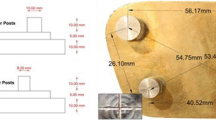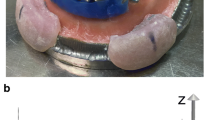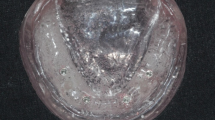Abstract
Vinyl polysiloxane (VPS) impression materials have application in a wide variety of situations in both fixed and removable prosthodontics. A major limitation of VPS impression materials is their hydrophobicity. There are two aspects of this problem, the wettability of the polymerized impression by dental gypsum materials and the ability of the unpolymerized material to wet intraoral tissues. To address this problem, manufacturers have added surfactants and labelled these new products as “hydrophilic vinyl polysiloxane.” The purpose of this study was to evaluate and compare dimensional accuracy and surface detail reproduction of four hydrophilic VPS impression materials, when used under dry, moist, and wet conditions. A total of 180 samples were made of stainless steel die similar to as described in ADA sp. no. 19. The die was scored with three horizontal and two vertical lines. Impressions were made under dry, moist and wet conditions. Dimensional accuracy was measured by comparing the length of the middle horizontal line in each impression to the same line on the metal die, by using Universal Length Measuring machine. A 2-way ANOVA was performed on the percentage change data for measured lengths of the 4 impression materials under the 3 conditions to evaluate dimensional accuracy. Surface detail was evaluated in two ways: (1) by use of criteria similar to ADA sp. no. 19 for detail reproduction, and (2) by use of a method that categorized the impressions as satisfactory or unsatisfactory based on their surface characteristics: presence of pits, voids, or roughness. Pearson X2 (α = 0.05) was used to compare surface detail reproduction results. Conditions (dry, moist, and wet) did not cause significant adverse effects on the dimensional accuracy of all the four material. With both surface detail analyses, dry, moist, and wet conditions had a significant effect on the detail reproduction of all the four materials (P < 0.05). The study concluded that the dimensional accuracy of all the four impression materials tested was well within ADA standards. Best surface detail results were obtained only under dry conditions for all the four materials.












Similar content being viewed by others
References
Mandikos MN (1998) Polyvinyl siloxane impression materials: an update on clinical use. Aust Dent J 43:428–434
Craig RG, Powers JM (2002) Impression materials. Restorative dental materials, 11th edn. Mosby, St Louis, pp 348–368
Chee WWL, Donovan TE (1992) Polyvinyl siloxane impression materials: a review of properties and techniques. J Prosthet Dent 68:728–732
Shen C (2003) Impression materials. Phillips’ Science of dental materials, 11th edn. Elsevier Science, Philadelphia, pp 205–231
Pratten DH, Craig RG (1989) Wettability of a hydrophilic addition silicone impression material. J Prosthet Dent 61:197–202
Chong YH, Soh G, Setchell DJ, Wickens JL (1990) Relationship between contact angles of die stone on elastomeric impression materials and voids in stone casts. Dent Mater 6:162–166
Derrien G, Menn GL (1995) Evaluation of detail reproduction for three die materials by using scanning electron microscopy and two-dimensional profilometry. J Prosthet Dent 74:1–7
Chai JY, Cheung T (1991) Wettability of nonaqueous elastomeric impression materials. Int J Prosthodont 4:555–560
Panichuttra R, Jones RM, Goodacre C, Munoz CA, Moore BK (1991) Hydrophilic Poly (vinyl siloxane) impression materials: dimensional accuracy, wettability, and effect on gypsum hardness. Int J Prosthodont 4:240–248
Ragain JC, Grosko ML, Raj M, Ryan TN, Johnston WM (2000) Detail reproduction, contact angles, and die hardness of elastomeric impression and gypsum die material combination. Int J Prosthodont 13:214–220
American National Standard/American Dental Association (1977) Specification no. 19 for non-aqueous, elastomeric dental impressions. J Am Dent Assoc 94:733–741
Craig RG (1988) Review of dental impression materials. Adv Dent Res 2:51–64
Lin CC, Ziebert GJ, Donegan SJ, Dhuru VB (1988) Accuracy of impression materials for complete-arch fixed partial dentures. J Prosthet Dent 59:288–291
Anusavice KJ (2003) Structure of matter and principles of adhesion. Phillips’ Science of dental materials, 11th edn. Elsevier Science, Philadelphia, pp 37–38
Michalakis KX, Bakopoulou A, Hirayama H, Garefis DP, Garefis PD (2007) Pre- and post-set hydrophilicity of elastomeric impression materials. J Prosthodont 16:238–248
Petrie CS, Walker MP, O´Mahony AM, Spencer P (2003) Dimensional accuracy and surface detail reproduction of two hydrophilic vinyl polysiloxane impression materials tested under dry, moist, and wet conditions. J Prosthet Dent 90:365–372
Walker MP, Petrie CS, Haj-Ali R, Spencer P, Dumas C, Williams K (2005) Moisture effect on polyether and polyvinyl siloxane dimensional accuracy and detail reproduction. J Prosthodont 14:158–163
Katyanan PA, Kakavathy N, Katyayan M (2011) Dimensional accuracy and detail reproduction of two hydrophilic vinyl polysiloxane impression materials tested under different conditions. Ind J Dent Res 22:220–225
Peutzfeldt A, Asmussen E (1988) Impression materials: effect of hydrophilicity and viscosity on ability to displace water from dentin surfaces. J Dent Res 96:253–259
Takahashi H, Finger WJ (1991) Dentin surface reproduction with hydrophilic and hydrophobic impression materials. Dent Mater 7:197–201
Aiasha T, Kumar S, Savadi RC (2010) Evaluation and comparison of surface detail reproduction of different elastomeric impression materials under dry and wet conditions. Trends Prosthodont Dent Implantol 1:5–8
Author information
Authors and Affiliations
Corresponding author
Rights and permissions
About this article
Cite this article
Nagrath, R., Lahori, M. & Agrawal, M. A Comparative Evaluation of Dimensional Accuracy and Surface Detail Reproduction of Four Hydrophilic Vinyl Polysiloxane Impression Materials Tested Under Dry, Moist, and Wet Conditions-An In Vitro Study. J Indian Prosthodont Soc 14 (Suppl 1), 59–66 (2014). https://doi.org/10.1007/s13191-014-0365-z
Received:
Accepted:
Published:
Issue Date:
DOI: https://doi.org/10.1007/s13191-014-0365-z




